Optimal Control Study of CCM SITO Buck Converter Based on Objective Holographic Feedback
Abstract
1. Introduction
2. Theory of Nonlinear Systems
2.1. Affine Nonlinear System
2.2. SIMO System Objective Holographic Feedback Nonlinear Control Idea
3. CCM SITO Buck Converter
3.1. Operating States and Switching Timings
- State I: Switching tubes S0 and S1 are on; S2, S3, and D are off; the input voltage Vin charges the inductor L and capacitor Ca while supplying power to the load Ra; and the inductor current rises linearly through the output branch a with a slope m1 = (Vin − Va)/L.
- State II: Diode D and switching tube S1 are on; S0, S2 and S3 are off; at this time, the energy stored in inductor L discharges capacitor Ca and load Ra; the inductor current changes through the output branch a with a slope −m2 = −Vin/L.
- State III: Switching tubes S0 and S2 are on; S1, S3, and D are off; the input voltage Vin charges the inductor L and capacitor Cb while supplying power to the load Rb; and the inductor current rises linearly through the output branch a with a slope m3 = (Vin − Vb)/L.
- State IV: Diode D and switching tube S2 are on; S0, S1, and S3 are off; at this time, the energy stored in inductor L discharges capacitor Cb and load Rb; the inductor current changes through the output branch a with a slope −m4 = −Vb/L.
- State V: Switching tubes S0 and S3 are on; S1, S2, and D are off; the input voltage Vin charges the inductor L and capacitor Cc while supplying power to the load Rc; and the inductor current rises linearly through the output branch a with a slope m5 = (Vin − Vc)/L.
- State VI: Diode D and switch tube S3 conduct; S0, S1, and S2 are off; inductor L discharges to capacitor Cc and load Rc; the inductor current through the output branch c with a slope −m6 = −Vc/L linearly decreases; and after a period of time, the system returns to the initial value, and the whole process is repeated from state I.
3.2. CCM SITO Buck Converter Switching Timing
3.3. Output Branch Steady-State DC Voltage Gain
4. CCM SITO Buck Converter Model and Control Design
4.1. CCM SITO Buck Converter Affine Nonlinear Model
4.2. Design of Objective Holographic Feedback Nonlinear Control Method for CCM SITO Buck Converter
4.3. Analysis of Objective Holographic Feedback Nonlinear Control Principle for CCM SITO Buck Converter
5. Simulation Experimental Results and Analysis of CCM SITO Buck Converter
5.1. Numerical Simulation Analysis
5.2. Comparison of Performance Results with Existing Literature
6. Physical Verification
7. Conclusions and Future Perspectives
Author Contributions
Funding
Data Availability Statement
Acknowledgments
Conflicts of Interest
References
- Chen, G.; Liu, Y.; Ma, M.; Hu, Y.; Qing, X. An independently controlled magnetic coupling multi-output buck converter with mixed modes for unbalanced loads. IEEE Trans. Ind. Inform. 2020, 16, 7499–7509. [Google Scholar] [CrossRef]
- Markkassery, S.; Saradagi, A.; Mahindrakar, A.D.; Lakshminarasamma, N.; Pasumarthy, R. Modeling, design and control of non-isolated single-input multi-output zeta–buck–boost converter. IEEE Trans. Ind. Appl. 2020, 56, 3904–3918. [Google Scholar]
- Mahjoub, S.; Labdai, S.; Chrifi-Alaoui, L.; Drid, S.; Derbel, N. Design and implementation of a Fuzzy logic supervisory based on SMC controller for a Dual Input-Single Output converter. Int. J. Electr. Power Energy Syst. 2023, 150, 109053. [Google Scholar] [CrossRef]
- Sambaiah, K.S.; Jayabarathi, T. Optimal Modeling and Allocation of Mixed Wind and Solar Generation Systems in Electric Distribution Networks. IETE J. Res. 2022, 68, 4129–4141. [Google Scholar] [CrossRef]
- Chen, G.; Liu, Y.; Qing, X.; Ma, M.; Lin, Z. Principle and topology derivation of single-inductor multi-input multi-output DC–DC converters. IEEE Trans. Ind. Electron. 2021, 68, 25–36. [Google Scholar] [CrossRef]
- Hosseini, A.; Badeli, A.S.; Davari, M.; Sheikhaei, S.; Gharehpetian, G.B. A Novel, Software-Defined Control Method Using Sparsely Activated Microcontroller for Low-Power, Multiple-Input, Single-Inductor, Multiple-Output DC–DC Converters to Increase Efficiency. IEEE Trans. Ind. Electron. 2023, 70, 2959–2970. [Google Scholar] [CrossRef]
- Liu, W.; Zhang, H.; Zhang, X.; Liu, W. Dynamical Analysis of Hybrid-Scale Bifurcation in One-Cycle Controlled Single-Inductor Dual-Output Buck DC–DC Converters. Int. J. Bifurc. Chaos 2023, 33, 2350004. [Google Scholar] [CrossRef]
- Patra, P.; Patra, A.; Misra, N. A single-inductor multiple-output switcher with simultaneous buck, boost, and inverted outputs. IEEE Trans. Power Electron. 2012, 27, 1936–1951. [Google Scholar] [CrossRef]
- Huang, W.; Qahouq, J.A.A.; Dang, Z. CCM–DCM power-multiplexed control scheme for single-inductor multiple-output DC–DC power converter with no cross regulation. IEEE Trans. Ind. Appl. 2017, 53, 1219–1231. [Google Scholar] [CrossRef]
- Goh, T.Y.; Ng, W.T. Single discharge control for single-inductor multiple-output DC–DC buck converters. IEEE Trans. Power Electron. 2018, 33, 2307–2316. [Google Scholar] [CrossRef]
- Wang, Y.; Xu, J.; Zhou, G. A cross regulation analysis for single-inductor dual-output CCM buck converters. J. Power Electron. 2016, 16, 1802–1812. [Google Scholar] [CrossRef]
- Jin, W.; Lee, A.T.L.; Tan, S.C.; Hui, S.R. Single-inductor multiple-output inverter with precise and independent output voltage regulation. IEEE Trans. Power Electron. 2020, 35, 11222–11234. [Google Scholar] [CrossRef]
- Nayak, G.; Nath, S. Decoupled voltage-mode control of coupled inductor single-input dual-output buck converter. IEEE Trans. Ind. Appl. 2020, 56, 4040–4050. [Google Scholar] [CrossRef]
- Zheng, Y.; Guo, J.; Leung, K.N. A single-inductor multiple-output buck/boost DC–DC converter with duty-cycle and control-current predictor. IEEE Trans. Power Electron. 2020, 35, 12022–12039. [Google Scholar] [CrossRef]
- Chen, H.; Huang, C.J.; Kuo, C.C.; Lin, L.-C.; Ma, Y.-S.; Yang, W.-H.; Chen, K.-H.; Lin, Y.-H.; Lin, S.-R.; Tsai, T.-Y. A single-inductor dual-output converter with the stacked MOSFET driving technique for low quiescent current and cross regulation. IEEE Trans. Power Electron. 2019, 34, 2758–2770. [Google Scholar] [CrossRef]
- Li, X.L.; Dong, Z.; Chi, K.T.; Lu, D.D.C. Single-inductor multi-input multi-output DC–DC converter with high flexibility and simple control. IEEE Trans. Power Electron. 2020, 35, 13104–13114. [Google Scholar] [CrossRef]
- Ma, D.; Ki, W.H.; Tsui, C.Y.; Mok, P. Single-inductor multiple-output switching converters with time-multiplexing control in discontinuous conduction mode. IEEE J. Solid-State Circuits 2003, 38, 89–100. [Google Scholar]
- Ma, D.; Ki, W.H.; Tsui, C.Y. A pseudo-CCM/DCM SIMO switching converter with freewheel switching. IEEE J. Solid-State Circuits 2003, 38, 1007–1014. [Google Scholar]
- Wang, Y.; Xu, J.; Qin, F.; Mou, D. A capacitor current and capacitor voltage ripple controlled SIDO CCM buck converter with wide load range and reduced cross regulation. IEEE Trans. Ind. Electron. 2022, 69, 270–281. [Google Scholar] [CrossRef]
- Nayak, G.; Nath, S. Unified model of peak current mode controlled coupled SIDO converters. IEEE Trans. Ind. Electron. 2021, 69, 11156–11164. [Google Scholar] [CrossRef]
- Din, A.F.U.; Mir, I.; Gul, F.; Akhtar, S. Development of reinforced learning based non-linear controller for unmanned aerial vehicle. J. Ambient. Intell. Hum. Comput. 2023, 14, 4005–4022. [Google Scholar] [CrossRef]
- Taimoor, M.; Aijun, L.; Samiuddin, M. Sliding mode learning algorithm based adaptive neural observer strategy for fault estimation, detection and neural controller of an aircraft. J. Ambient. Intell. Hum. Comput. 2021, 12, 2547–2571. [Google Scholar] [CrossRef]
- Duan, G. Theory of Linear Systems; Science Press: Beijing, China, 2016. [Google Scholar]
- Wang, Y.; Xu, L.; Li, A.; Liao, K. Dynamic behavior analysis of current-type controlled single inductor dual output Buck converter. Chin. J. Electr. Eng. 2017, 37, 643–652. [Google Scholar]
- Zheng, L.; Lu, S. Control method for fast timescale bifurcation of Boost PFC converter. Power Autom. Equip. 2013, 33, 68–73. [Google Scholar]
- Lascu, C. Sliding-mode direct-voltage control of voltage-source converters with LC filters for pulsed power loads. IEEE Trans. Ind. Electron. 2021, 68, 11642–11650. [Google Scholar] [CrossRef]
- Wai, R.J.; Chen, M.W.; Liu, Y.K. Design of adaptive control and fuzzy neural network control for single-stage boost inverter. IEEE Trans. Ind. Electron. 2015, 62, 5434–5445. [Google Scholar] [CrossRef]
- Trevisan, D.; Mattavelli, P.; Tenti, P. Digital control of single-inductor multiple-output step-down DC–DC converters in CCM. IEEE Trans. Ind. Electron. 2008, 55, 3476–3483. [Google Scholar] [CrossRef]
- Dasika, J.D.; Bahrani, B.; Saeedifard, M.; Karimi, A.; Rufer, A. Multivariable control of single-inductor dual-output buck converters. IEEE Trans. Power Electron. 2014, 29, 2061–2070. [Google Scholar] [CrossRef]
- Wang, Y.; Xu, J.; Yin, G. Cross-regulation suppression and stability analysis of capacitor current ripple controlled SIDO CCM buck converter. IEEE Trans. Ind. Electron. 2019, 66, 1770–1780. [Google Scholar] [CrossRef]
- Zhou, S.; Zhou, G.; Liu, G.; Mao, G. Small-signal modeling and cross-regulation suppressing for current-mode controlled single-inductor dual-output DC–DC converters. IEEE Trans. Ind. Electron. 2021, 68, 5744–5755. [Google Scholar] [CrossRef]
- Patra, P.; Ghosh, J.; Patra, A. Control scheme for reduced cross-regulation in single-inductor multiple-output DC–DC converters. IEEE Trans. Ind. Electron. 2013, 60, 5095–5104. [Google Scholar] [CrossRef]
- Zhou, S.; Zhou, G.; He, M.; Liu, X. The Voltage-mode-ripple Variable Frequency Control for Single-inductor Triple-output Switching Converter. Proc. CSEE 2021, 41, 6003–6013. [Google Scholar]
- Judewicz, M.G.; González, S.A.; Gelos, E.M.; Fischer, J.R.; Carrica, D.O. Exact Feedback Linearization Control of Three-Level Boost Converters. IEEE Trans. Ind. Electron. 2023, 70, 1916–1926. [Google Scholar] [CrossRef]
- Mahmud, M.A.; Roy, T.K.; Saha, S.; Haque, M.E.; Pota, H.R. Robust nonlinear adaptive feedback linearizing decentralized controller design for islanded DC microgrids. IEEE Trans. Ind. Appl. 2019, 55, 5343–5352. [Google Scholar] [CrossRef]
- Chen, C.; Ye, Z.; Huang, J.; Yu, Y.; Xia, Y.; Gao, J. Affine nonlinear control of a multivariate inductive power transfer system with exact linearization. IEEE Trans. Power Electron. 2020, 35, 12728–12740. [Google Scholar] [CrossRef]
- Wu, J.; Lu, Y. Exact feedback linearisation optimal control for single-inductor dual-output boost converter. IET Power Electron. 2020, 13, 2293–2301. [Google Scholar] [CrossRef]
- Li, J.; Zhou, P.; Pan, H.; Feng, D.; Liu, B. Reduced-order controller design for Cuk converters based on objective holographic feedback. J. Power Electron. 2023, 23, 181–190. [Google Scholar] [CrossRef]
- Li, X.; Chen, D.; Liu, S. Multi-objective feedback nonlinear control method for multi-input multi-output differential-algebraic systems. Chin. J. Electr. Eng. 2020, 40, 1465–1474. [Google Scholar]
- Li, J.; Pan, H.; Long, X.; Liu, B. Objective holographic feedbacks linearization control for boost converter with constant power load. Int. J. Electr. Power Energy Syst. 2022, 134, 107310. [Google Scholar] [CrossRef]
- Li, J.; Chen, P.; Zhou, P. Sliding-mode variational structure study of Cuk converter based on target holographic feedback. Int. J. Circ. Theor. Appl. 2024, 52, 1–20. [Google Scholar] [CrossRef]
- Nayak, G.; Nath, S. Small Signal Modeling and Analysis of Single Input Three Output Buck Converter Using Coupled Inductor. In Proceedings of the 2019 National Power Electronics Conference (NPEC), Tiruchirappalli, India, 13–15 December 2019; pp. 1–6. [Google Scholar] [CrossRef]
- Xie, F. Research on Common Mode-Differential Mode Control Single Inductor Dual Output Buck Converter. Master’s Thesis, Shaanxi University of Science and Technology, Xi’an, China, 2021. [Google Scholar] [CrossRef]
- Wang, B.; Xian, L.; Kanamarlapudi, V.R.K.; Tseng, K.J.; Ukil, A.; Gooi, H.B. A digital method of power-sharing and cross-regulation suppression for single-inductor multiple-input multiple-output DC–DC converter. IEEE Trans. Ind. Electron. 2017, 64, 2836–2847. [Google Scholar] [CrossRef]
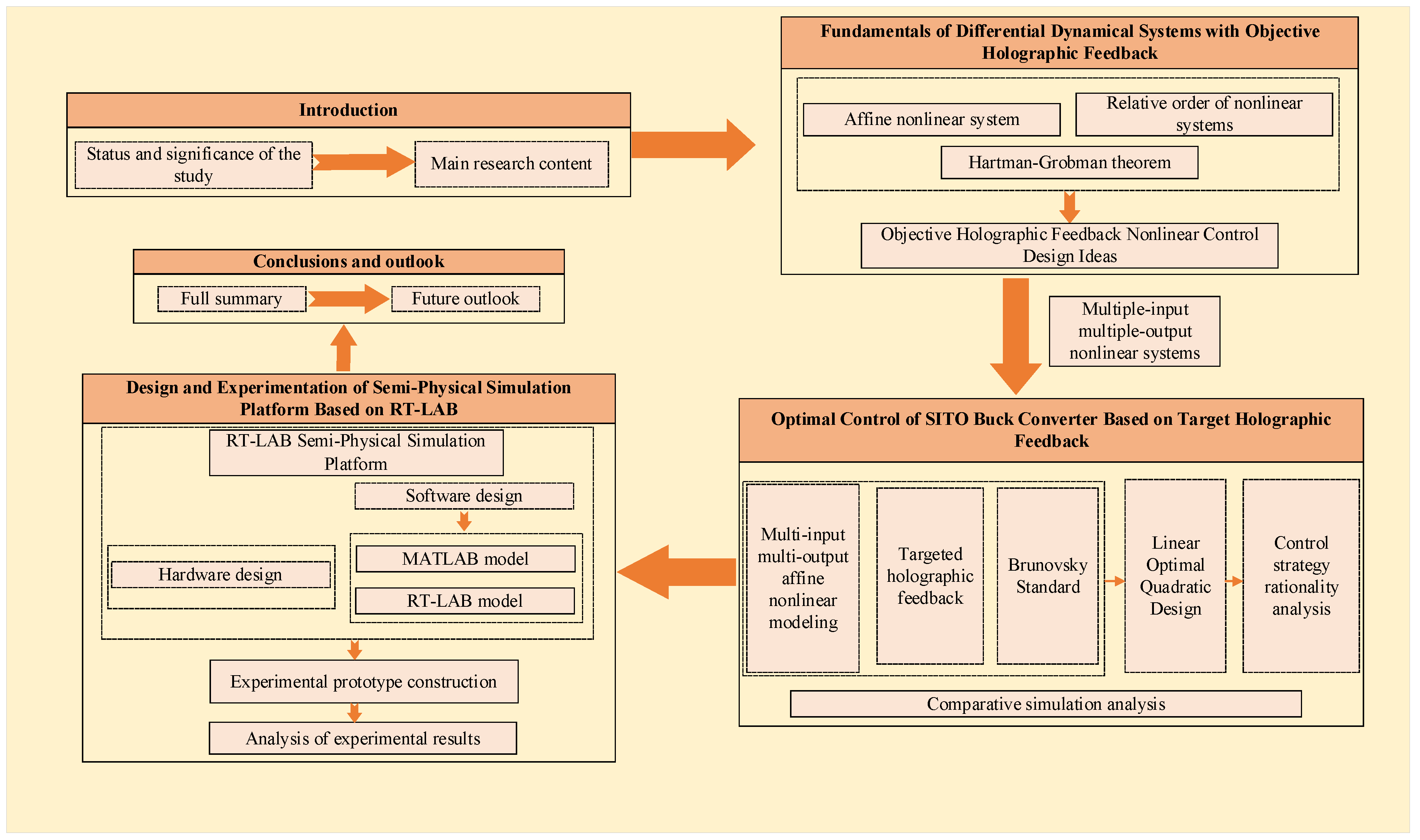
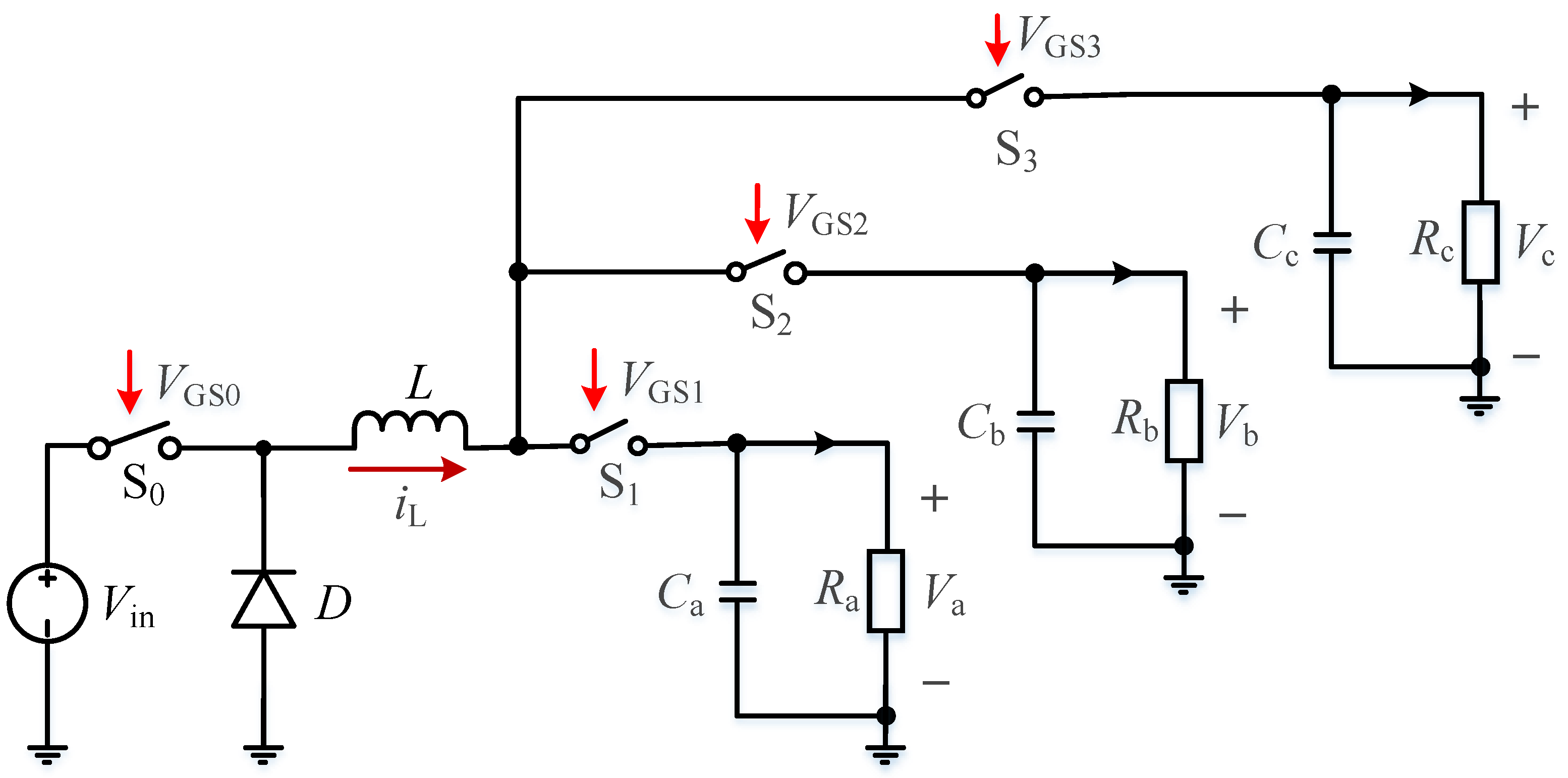
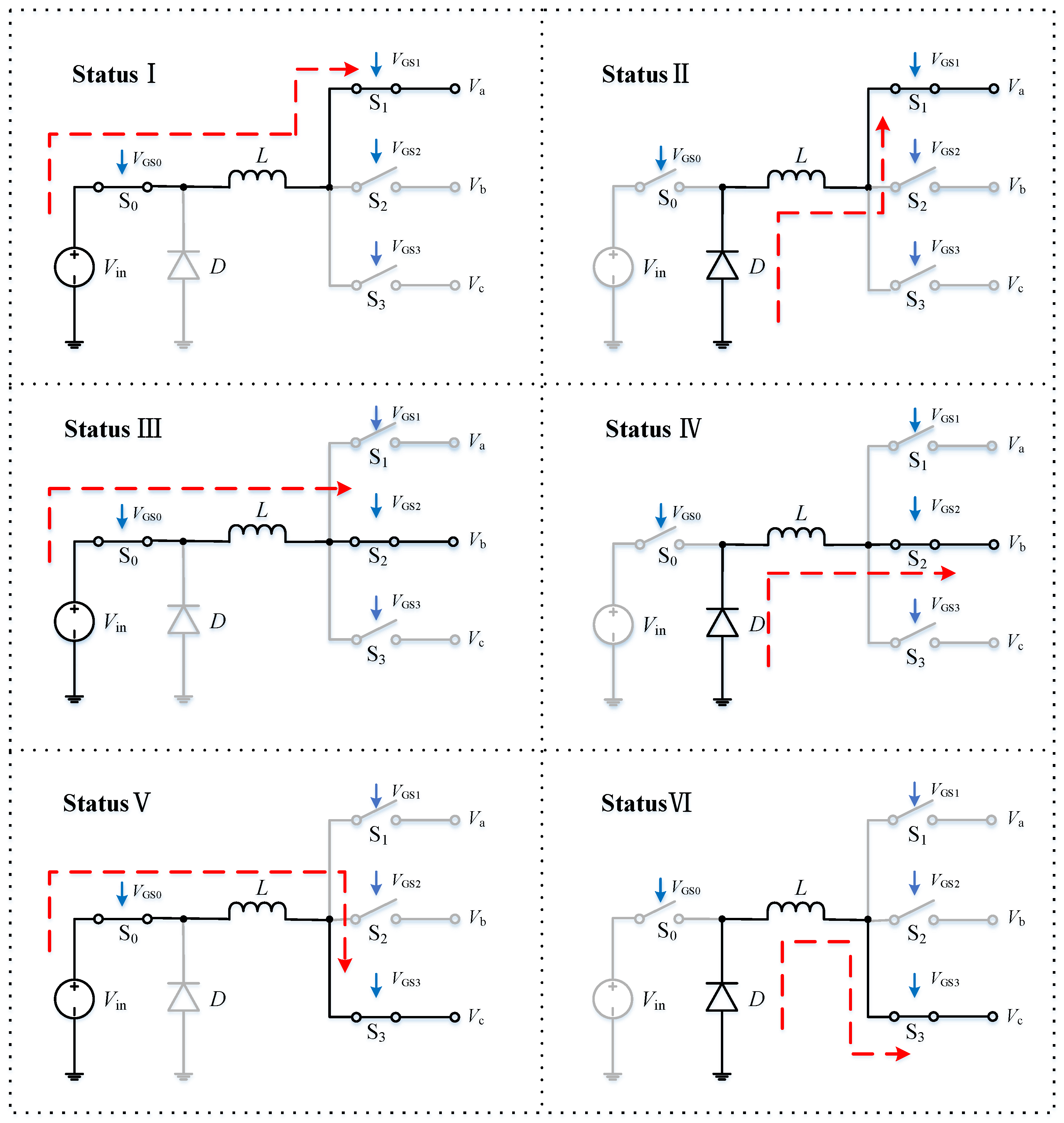
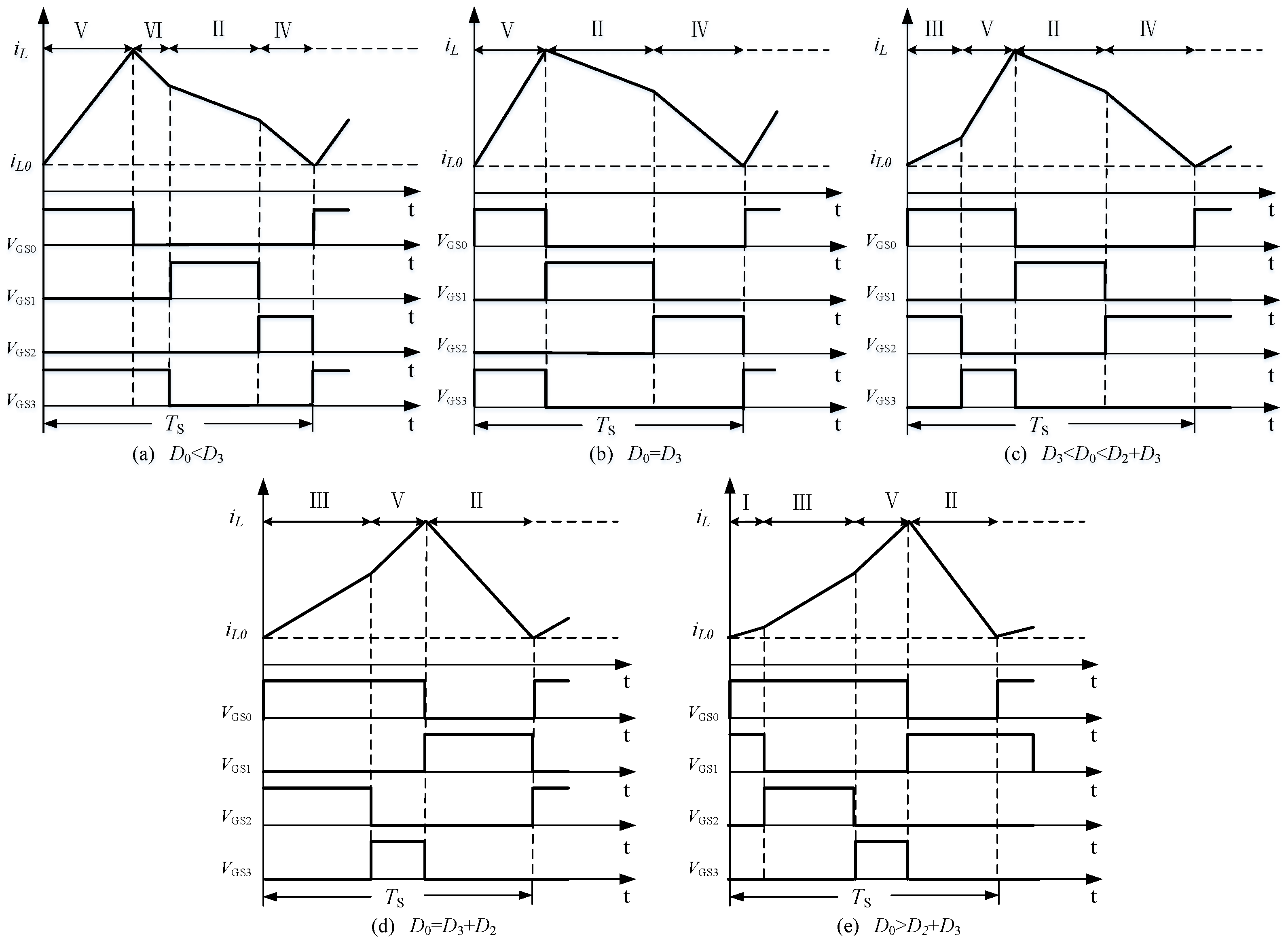
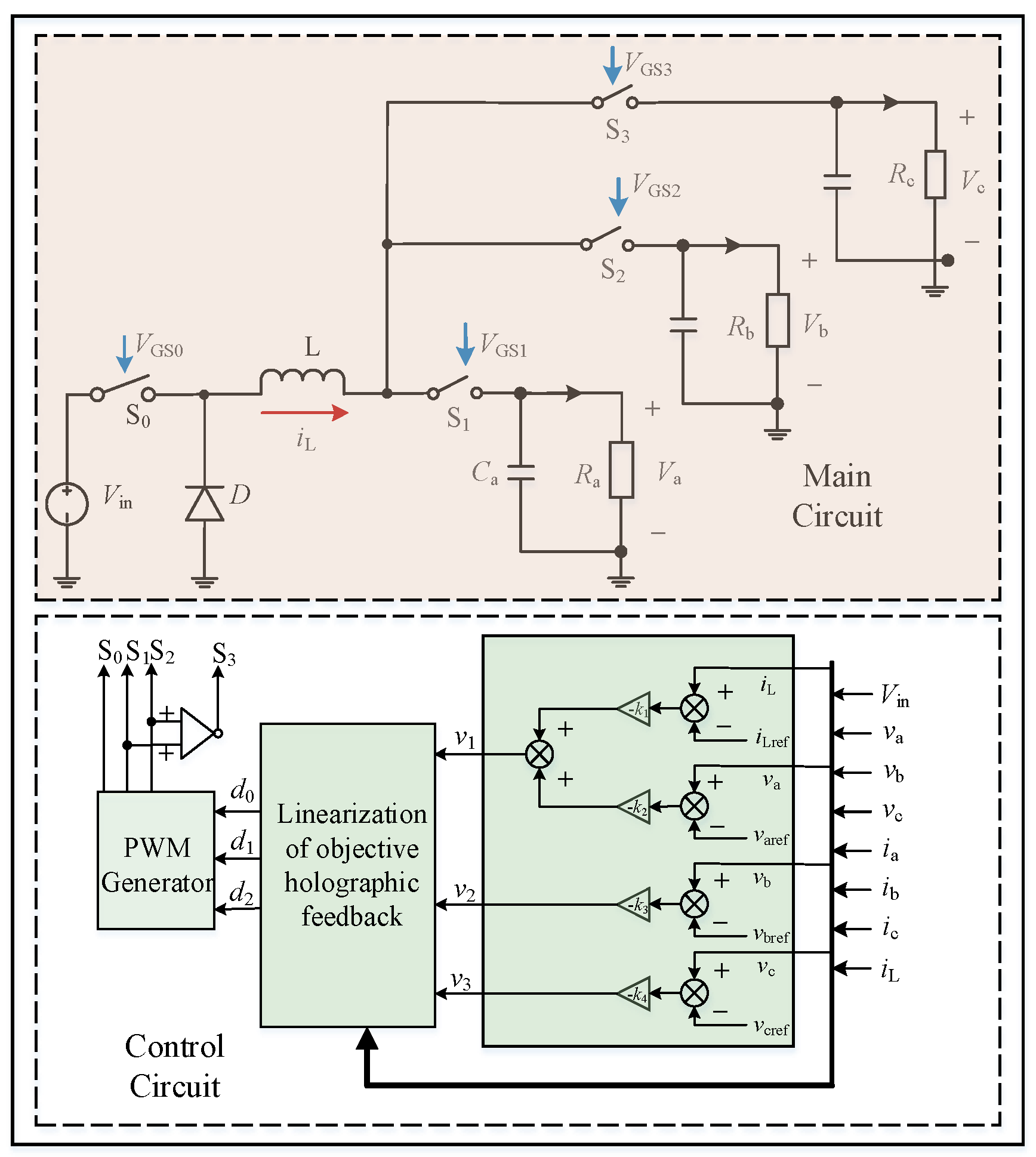
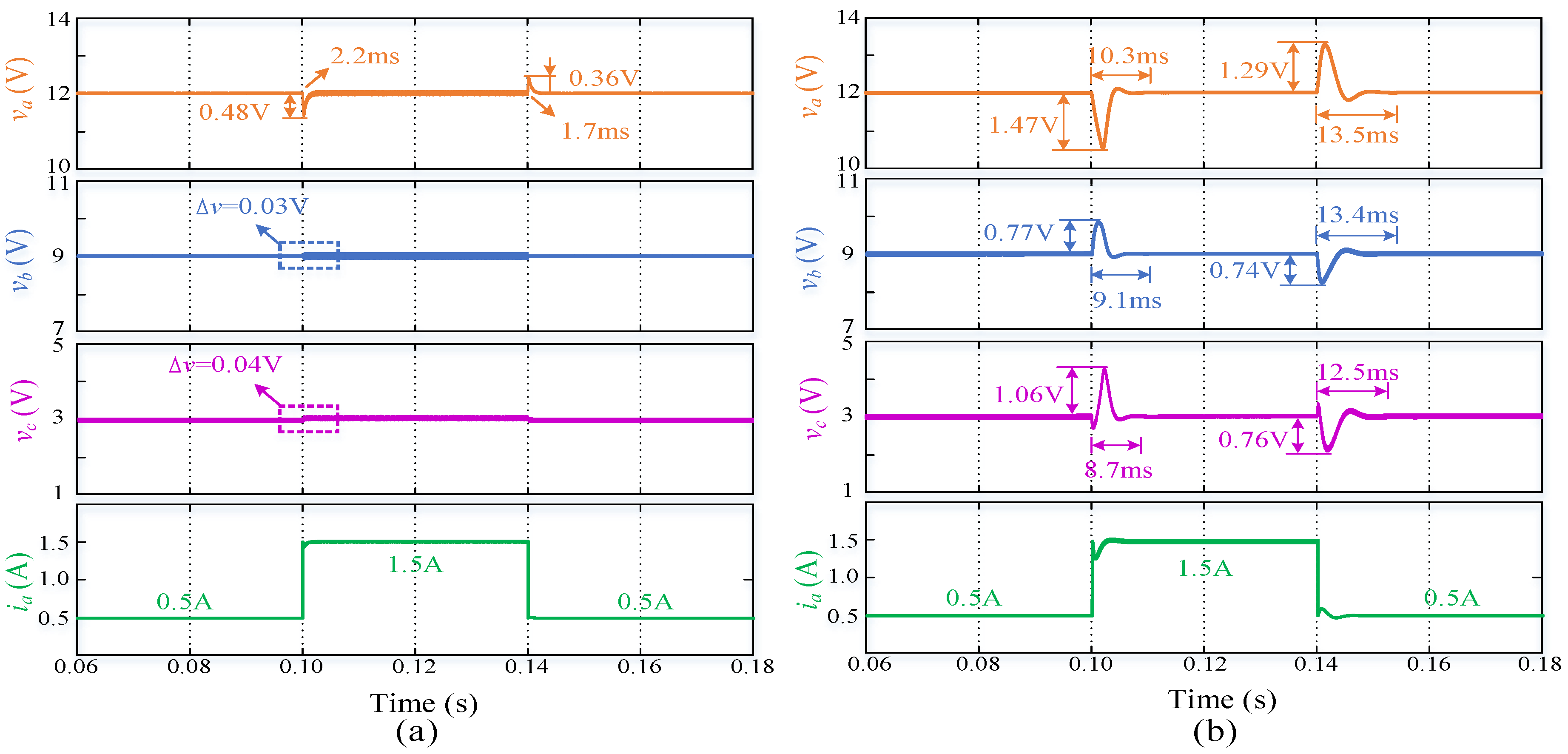
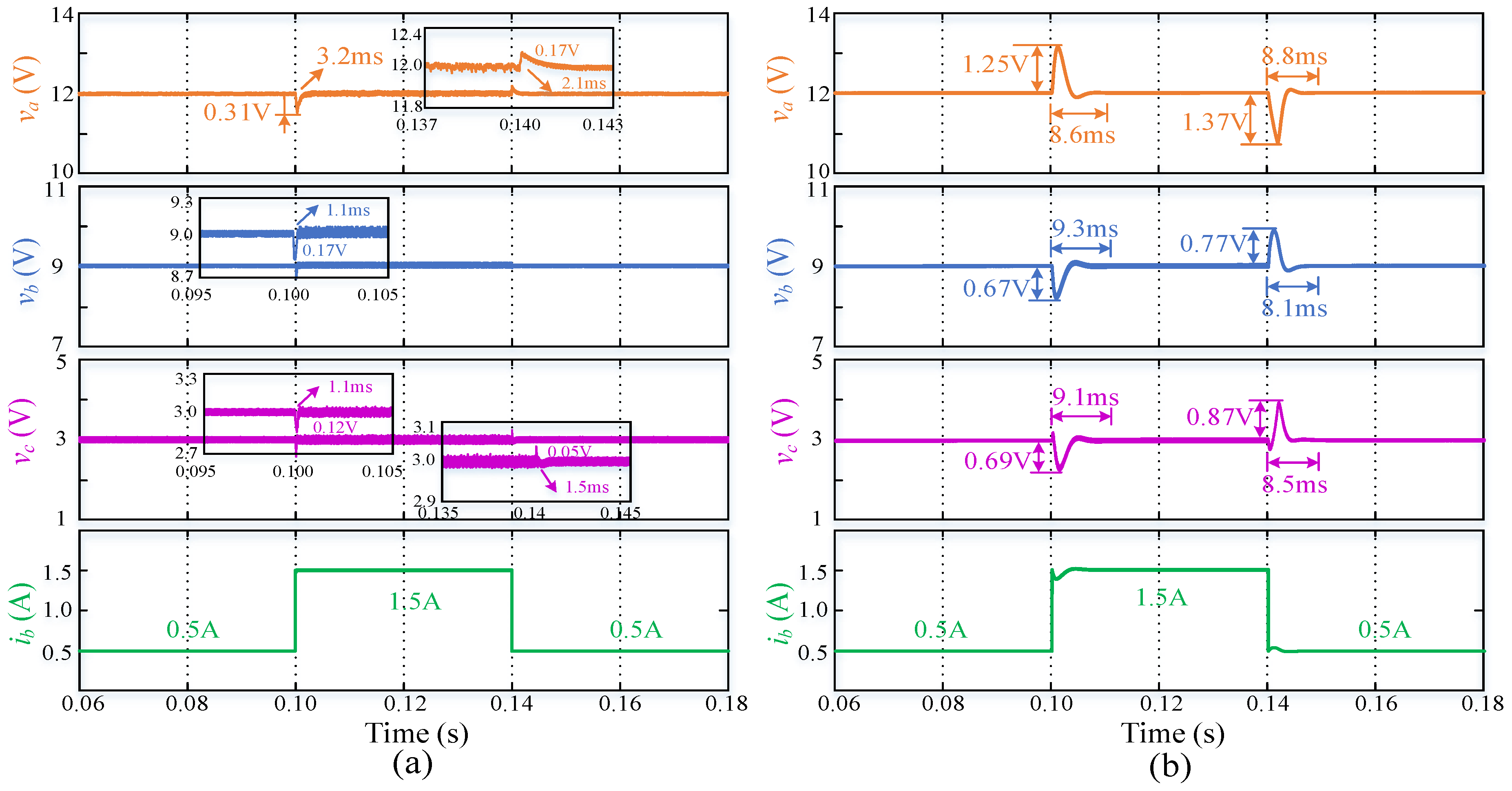

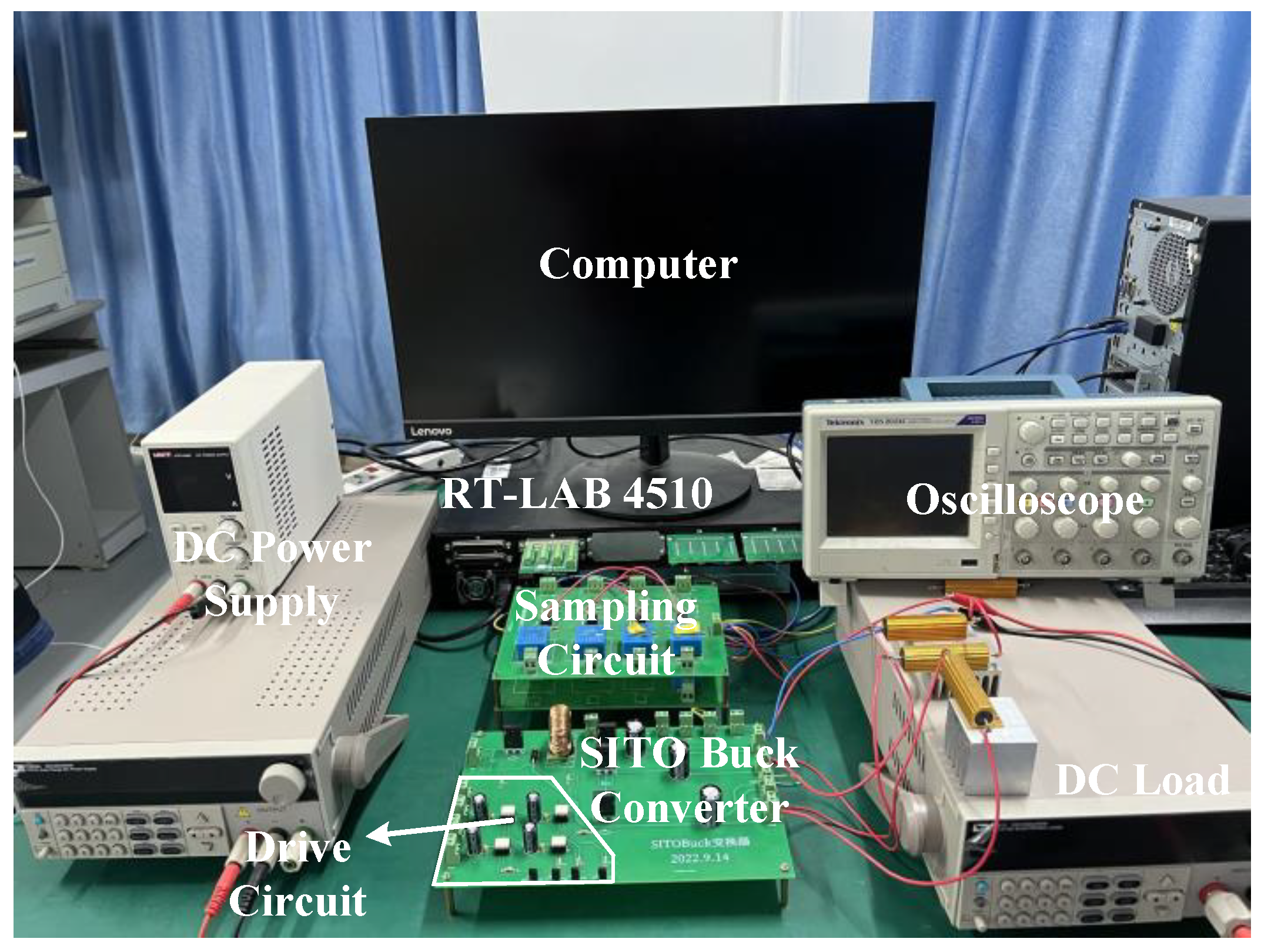



| Parameters | Value | Parameters | Value |
|---|---|---|---|
| Input voltage Vin/V | 20 | Output load resistance Rb/Ω | 18 |
| Inductor L/mH | 1 | Output load resistance Rc/Ω | 6 |
| Output capacitance Ca/μF | 470 | Reference voltage varef/V | 12 |
| Output capacitance Cb/μF | 470 | Reference voltage vbref/V | 9 |
| Output capacitance Cc/μF | 470 | Reference voltage vcref/V | 3 |
| Output load resistance Ra/Ω | 24 | Switching frequency T/µs | 20 |
| OHFNC | Common Mode-Differential Mode Voltage Control | ||||
|---|---|---|---|---|---|
| Load Variation/A | Output Voltage | Variation in Voltage/V | Recovery Time/ms | Variation in Voltage/V | Recovery Time/ms |
| ia (0.5→1.5→0.5) | va | 0.48/0.36 | 2.2/1.7 | 1.47/1.29 | 10.3/13.5 |
| vb | 0.03/0.03 | 1.1/1.1 | 0.77/0.74 | 9.1/13.4 | |
| vc | 0.04/0.04 | 1.2/1.2 | 1.06/0.76 | 8.7/12.5 | |
| ib (0.5→1.5→0.5) | va | 0.31/0.17 | 3.2/2.1 | 1.25/1.37 | 8.6/8.8 |
| vb | 0.17/0.02 | 1.1/1.1 | 0.67/0.77 | 9.3/8.1 | |
| vc | 0.12/0.05 | 1.1/1.5 | 0.69/0.87 | 9.1/8.5 | |
| ic (0.5→1.5→0.5) | va | 0.19/0.19 | 2.5/2.8 | 0.57/0.63 | 5.5/8.4 |
| vb | 0.03/0.04 | 1.2/1.3 | 0.34/0.37 | 7.1/7.8 | |
| vc | 0.11/0.05 | 1.8/1.6 | 0.68/0.79 | 6.5/9.7 | |
| Load Variation (0.5 A→1.5 A) | δva/Va | δvb/Vb | δvc/Vc |
|---|---|---|---|
| δia/Ia (1.0 A/0.5 A) | 0.48 V/12 V | 0.03 V/9 V | 0.04 V/3 V |
| FOM(cross) | — | 0.0017 | 0.0067 |
| δib/Ib (1.0 A/0.5 A) | 0.31 V/12 V | 0.17 V/9 V | 0.12 V/3 V |
| FOM(cross) | 0.0129 | — | 0.0200 |
| δic/Ic (1.0 A/0.5 A) | 0.19 V/12 V | 0.03 V/9 V | 0.11 V/3 V |
| FOM(cross) | 0.0079 | 0.0017 | — |
| Parameters | Paper [28] | Paper [37] | This Article |
|---|---|---|---|
| Input Voltage/V | 20 | 12 | 20 |
| Output Voltage/V | 12, 9, 3 | 30, 10 | 12, 9, 3 |
| Switching frequency/kHz | 50 | 25 | 20 |
| Inductors/μH | 1000 | 100 | 1000 |
| Capacitance/μF | 470 | 470 | 470 |
| FOM(cross)max | 0.167 | 0.023 | 0.020 |
| Load Variation/A | Output Voltage | Variation Voltage /V | Recovery Time/ms |
|---|---|---|---|
| ia (0.5→1.5→0.5) | va | 0.9/0.8 | 5/6 |
| vb | 0.6/0.7 | 5/6 | |
| vc | 0.2/0.3 | 3/4 | |
| ib (0.5→1.5→0.5) | va | 0.9/1.0 | 5/8 |
| vb | 0.8/0.8 | 5/8 | |
| vc | 0.1/0.2 | 3/3 | |
| ic (0.5→1.5→0.5) | va | 2.0/1.8 | 8/8 |
| vb | 2.0/1.5 | 8/9 | |
| vc | 0.9/0.8 | 4/5 |
Disclaimer/Publisher’s Note: The statements, opinions and data contained in all publications are solely those of the individual author(s) and contributor(s) and not of MDPI and/or the editor(s). MDPI and/or the editor(s) disclaim responsibility for any injury to people or property resulting from any ideas, methods, instructions or products referred to in the content. |
© 2025 by the authors. Licensee MDPI, Basel, Switzerland. This article is an open access article distributed under the terms and conditions of the Creative Commons Attribution (CC BY) license (https://creativecommons.org/licenses/by/4.0/).
Share and Cite
Li, J.; Dong, H.; Chen, P.; Zhou, P. Optimal Control Study of CCM SITO Buck Converter Based on Objective Holographic Feedback. Electronics 2025, 14, 717. https://doi.org/10.3390/electronics14040717
Li J, Dong H, Chen P, Zhou P. Optimal Control Study of CCM SITO Buck Converter Based on Objective Holographic Feedback. Electronics. 2025; 14(4):717. https://doi.org/10.3390/electronics14040717
Chicago/Turabian StyleLi, Jiyong, Hao Dong, Peiwen Chen, and Pengcheng Zhou. 2025. "Optimal Control Study of CCM SITO Buck Converter Based on Objective Holographic Feedback" Electronics 14, no. 4: 717. https://doi.org/10.3390/electronics14040717
APA StyleLi, J., Dong, H., Chen, P., & Zhou, P. (2025). Optimal Control Study of CCM SITO Buck Converter Based on Objective Holographic Feedback. Electronics, 14(4), 717. https://doi.org/10.3390/electronics14040717





